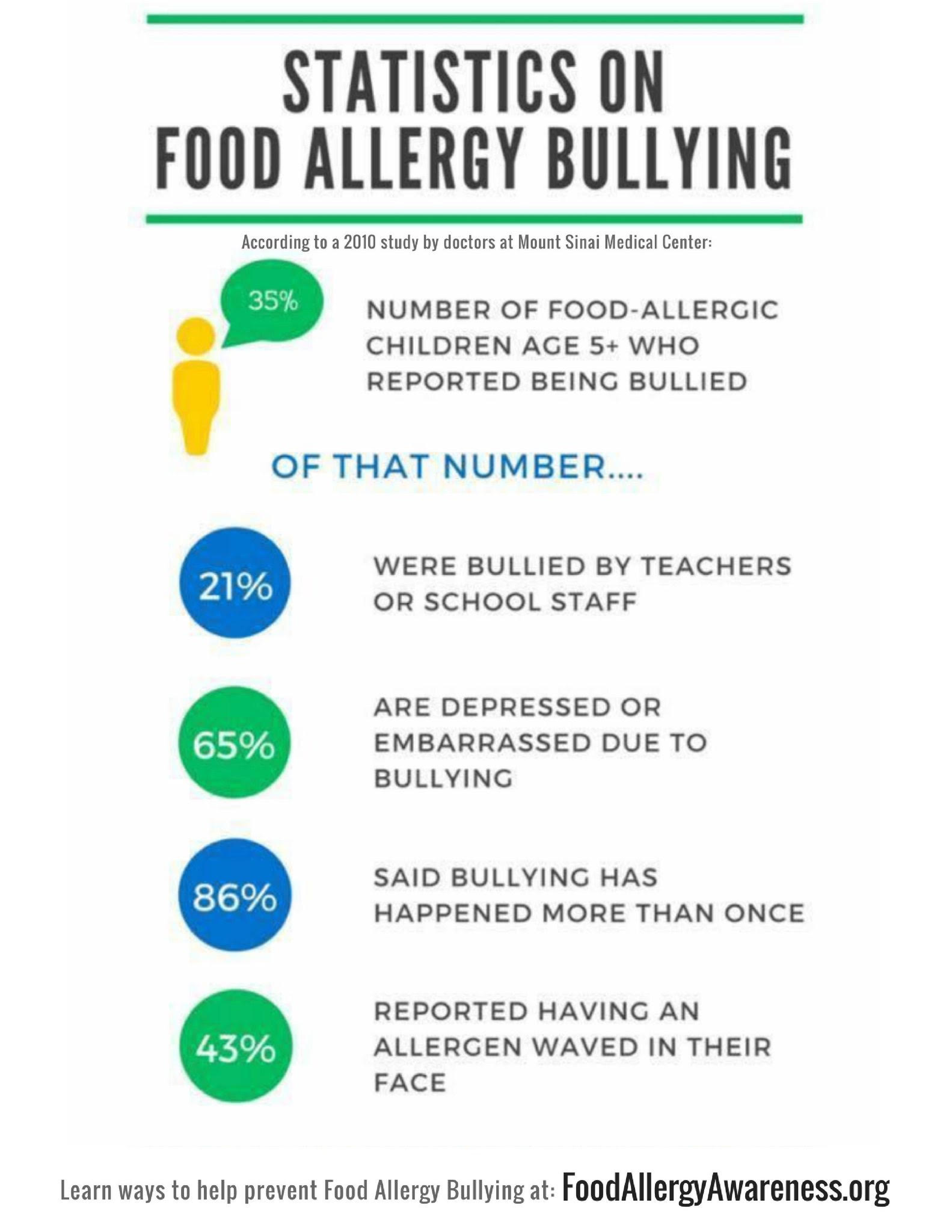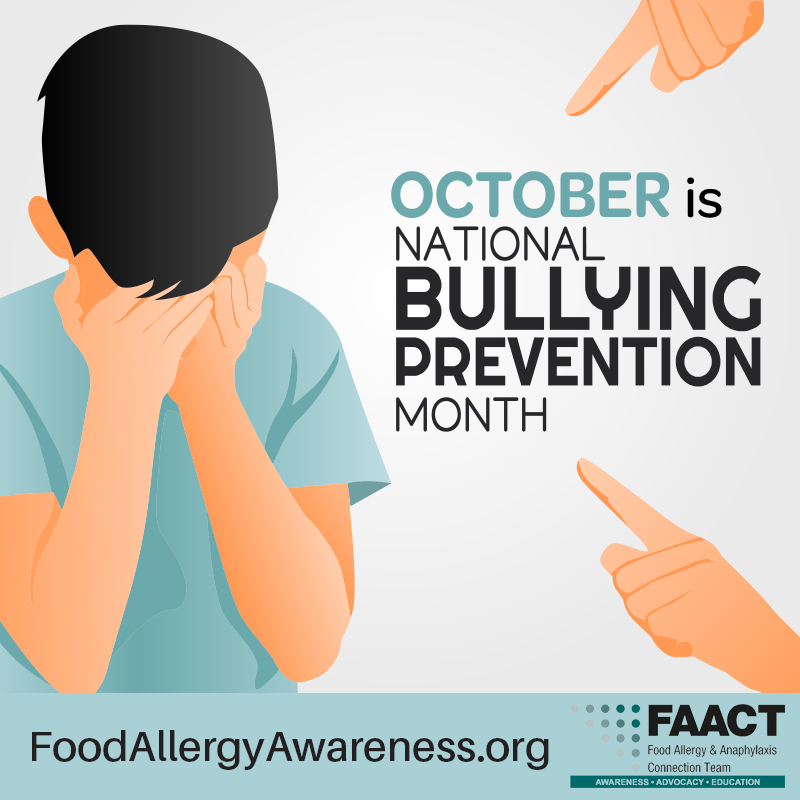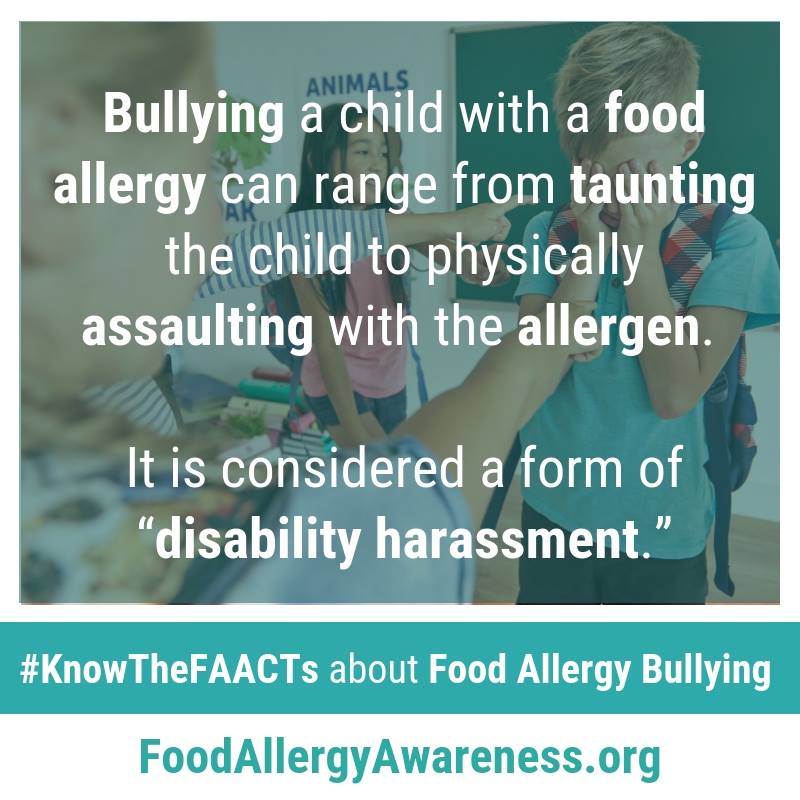Education
Bullying
Back to Category View.jpg)
Bullying Resources for Educators and Parents/Caregivers
| BULLYING /boolē-ēng/ verb. Unwanted, aggressive behavior that involves a real or perceived power imbalance. The behavior is repeated, or has the potential to be repeated, over time. Includes making threats, spreading rumors, attacking someone physically or verbally, and excluding someone from a group on purpose.[1] |
Bullying children with food allergy is common and associated with a lower quality of life for the child being bullied. Reasons for bullying can range from the child appearing “different” to the lack of food allergy education and awareness among students and school staff. Bullying can result in emotional distress for both the child and parent/caregiver as well as physical harm to the bullying victim.
Read more about this issue in The American Academy of Pediatrics publication, Child and Parental Reports of Bullying in a Consecutive Sample of Children with Food Allergy.
* Please read FAACT's CEO, Eleanor Garrow-Holding's, article with Living Without Magazine titled Food Allergy Bullying, which was published in the January 2013 issue. She shares her story when her son, Thomas, was bullied in second grade while living in Northern Virginia and what she had to do to advocate for him to keep him safe in school. The article covers the risks, the warning signs, your rights, and more.
.jpg)
Facts about Bullying
Bullying a student with food allergies is considered a form of disability harassment. Some incidents may meet the criteria for lawful consequence. Following are rare but serious examples of peer-to-peer bullying that resulted in such consequences:
- CBS News: Bully tries to poison student with peanuts
- NBC News: Peanut menace bullies use food to torment allergic kids
Why Do Children/Teens Bully Kids with Food Allergies?
Children who bully food-allergic peers generally do so because there is a lack of awareness and education about food allergies and their consequences. In addition, children model adult behaviors. Refusing to invite a food-allergic child to a social event, for example, because a parent doesn’t want to “deal” with (accommodate) the food allergies excludes the food-allergic child and makes the child appear “different.” It then appears socially acceptable for children to exclude the food-allergic child in all social activities. The result is that the food-allergic child becomes the outcast. In many cases, children who appear different are bullied no matter the type of disability. It is important to advocate for a more inclusive environment to reduce the incidence of bullying. Additionally, work with other parents to show that it is possible to accommodate food-allergic children.
There have only been 10 studies conducted in the United States on bullying students with disabilities. However, all have found that students with developmental disabilities were two to three times more likely to be bullied than nondisabled peers. Of these disabled students being bullied, 42.9 percent reported having a special health conditions. Bullying affects a student’s ability to learn. Additionally, a study published in the British Journal of Learning Support (2008) concluded that 60 percent of children with disabilities reported being bullied regularly compared with 25 percent of all students.
What Do “Disabilities” Have to Do with Food Allergies?
Food allergy anaphylaxis is a health impairment that substantially limits one or more major life activities, such as breathing and eating, under the Americans with Disabilities Act Amendment Act (ADAAA). Therefore, students with food allergies are considered “disabled” under these terms. Students with food allergies are offered equal access to programs and activities provided by facilities who receive Federal financial assistance, including public schools, under Section 504 of the Rehabilitation Act of 1973, which is a non-discriminatory regulation for students with disabilities. Parents should refer their child for a Section 504 evaluation in order for the child to be found eligible to receive appropriate accommodations. Bullying students with disabilities has become such a problem that the U.S. Department of Education has published a Dear Colleague letter outlining districts responsibilities to students with disabilities and bullying.
Furthermore, as explained in the a blog post from the U.S. Department of Education about the letter, “Schools have an obligation to ensure that a student with disabilities who is bullied continues to receive FAPE as outlined in his or her individualized education program (IEP). IEPs, as well as 504 plans, can be useful in outlining specialized approaches for preventing and responding to bullying, as well as providing additional supports and services to students with disabilities. This guidance also offers effective evidence-based practices for preventing and addressing bullying.” To clarify, the Department of Education has encouraged outlining support in a student’s IEP or 504 plan detailing how to address bullying.

Food Allergy Bullying Statistics
A 2010 study by doctors at Mount Sinai Medical Center[2] found that among children older than five who have food allergies, 35 percent experienced bullying, teasing, or harassment due to food allergies. Of those children,
- 86 percent said the bullying happened more than once.
- 82 percent of the bullying incidents happened at school.
- 80 percent were bullied by other students.
- 21 percent were bullied by a teacher or other school staff.
- 79 percent said the bullying was due to food allergies alone. Others reported bullying related to other issues, including carrying medication, being set apart at lunch, and getting “special treatment.”
- More than 20 percent were harassed by teachers and staff.
- 43 percent reported having an allergen waved in their faces.
- 65 percent reported feeling depressed or embarrassed because of the bullying.
The study concluded that “Bullying, teasing, and harassment of children with food allergy seems to be common, frequent, and repetitive. These actions pose emotional and physical risks that should be addressed in food allergy management.”
Risk-Taking and Coping Behaviors
Bullying has also been shown to increase risky behavior among children with food allergies. A study[3] of food-allergic youth ages 13 to 21 found that
- 39 percent do not carry their epinephrine auto-injector.
- 54 percent had purposely ingested potentially unsafe foods.
- 42 percent were willing to ingest foods that “may contain” an allergen.
- 68 percent believe that educating their friends would make living with food allergy easier.
Risk-taking behavior varied greatly depending on the social circumstances and perceived risks – possibly based on attempts to “fit in” with their peers. Researchers noted that “teens reported feeling different and less concerned about ingesting an allergen and have more recent reactions. The significance in this statement is that teens will eat products that may contain their allergens and/or have cross contamination label warnings. Medical professionals are concerned about this risk as they result in more recent reactions. These attempts by teens appear as an attempt for inclusion and fitting in peer social situations.” The research indicates that educating teens and their peers might reduce risk taking and its consequences.
Bullying Intervention in School
Assistant professor of criminology and criminal justice at the University of Texas– Arlington, Seokjin Jeong, led a study on bullying. He found that schools that implemented anti-bullying programs were only marginally effective. Students attending schools with anti-bullying programs were actually more likely to be bullied. “The schools with interventions say, ‘You shouldn’t do this,’ or ‘You shouldn’t do that.’ But through the programs, the students become highly exposed to what a bully is and they know what to do or say when questioned by parents or teachers,” Jeong said. The study noted that improvements in the school climate resulted in decreased bullying victimization and antisocial behavior. “Security measures . . . and teachers’ awareness of anti-bullying policies and strategies can intervene to reduce peer victimization. Schools in which teachers are aware of school policies on bullying victimization tend to have fewer incidents of bullying victimizations.”
According to Stuart Twemlow, a visiting professor of health sciences at University College, London, “Targeting bullies is a great way to fail at stopping bullying.” A more effective way of reducing the bullying incidents is by improving the school climate, Twemlow explains. “Bullies are not the problem. Bullies are the result of the problem. And when you have a lot of bullies at a school, you have a problem with the leadership of the school. And that's complicated."
Impact of Inclusion in Schools to Reduce Bullying
Schools play an important role in a food-allergic student’s educational life – not just academically or in the health needs of the student but in ensuring that the food-allergic student is included in programs and activities provided by the school. In doing so, this helps reduce the risk of bullying incidents. For some educators, managing food allergies in the educational setting can seem daunting. The following list may help provide guidance for inclusion:
- Provide a safe environment by reducing the risk of exposure to the allergen in the classroom, whether that’s providing an allergen-free or food-free classroom according to the food-allergic student’s IHCP/Section 504 plan.
- Refrain from exposing the student’s medical privacy or labeling the student (“allergy kid”or “peanut boy/girl” or asking in front of all students, “Who here has the food allergy?”).
- Refrain from segregating students with food allergies to a separate area during activities. For example, having a student sit outside in the hallway or send the student to the library while performing an activity in the classroom “for the student’s safety.” A more acceptable way of safely performing the activity to include the student is to adhere to the student’s IHCP/Section 504 plan and/or refrain from using the student’s allergen in the classroom. Inclusion of students is important for all students to reduce bullying incidents.
- Participate in food allergy awareness campaigns. For example, Food Allergy Awareness Week.
- Improve the school culture and climate for both staff and students.
- Provide a Positive Behavioral Intervention and Supports program or similar program to promote and focus on positive behaviors (see resource below for link).
- If bullying occurred, it may be appropriate to maintain the food allergic student’s safe environment by not changing their schedule in order to provide comfort and familiarity. This is especially important so that the student has knowledge of trained staff who he/she is comfortable with going to for help.
Providing staff with inclusive practices for an improved school culture can reduce bullying incidents. If peers and staff are not educated on food allergies and schools do not provide a more inclusive environment, especially starting at the elementary level, it can contribute to the rise of bullying incidents. When food allergic students enter middle and high school, the bullying incidents can follow them and increase. This can result in emotional distress and anxiety, which is a barrier to learning.
FAACT:
Each year, an estimated 160,000 students miss school due to the fear of being bullied.

Resources
- Food Allergy Bullying Article with FAACT CEO, Eleanor Garrow-Holding, and Living Without Magazine, January 2013
- Framing Bullying for Educators
- Bullying - What Is Food Allergy Bullying?
- Bullying - Keys to Standing Up, Involvement, & Inclusion
Additional Resources:
- Cyberbullying Research Center - Resources for Educators
- Cyberbullying in College
- Inclusive Schools
- Positive Behavioral Interventions and Support (PBIS)
- StopBullying.gov
- The Bully Project - Educators
- The Bully Project - Special Needs for Educators
References:
[1] U.S. Department of Health and Human Services, StopBullying.gov (http://www.stopbullying.gov/what-is-bullying/definition/index.html), accessed December 2013.
[2] Sicherer, Scott et al. “Bullying among pediatric patients with food allergy.” Annals of Allergy, Asthma & Immunology, Vol 105, Issue 4 (October 2010).
[3] “Risk-taking and coping strategies of adolescents and young adults with food allergy.” Journal of Allergy and Clinical Immunology. 2006 Jun;117(6).

Bullying Signs & Symptoms
Children who are being bullied may not tell a parent/caregiver or other adult, so it is important to be aware of possible warning signs. Some of these behaviors may appear vague or may not immediately seem connected with bullying. Signs of bullying include:
- Unexplained injuries.
- Lost or destroyed clothing, books, electronics, or jewelry.
- Frequent headaches or stomach aches, feeling sick, or faking illness.
- Changes in eating habits, such as suddenly skipping meals or binge eating. Kids may come home from school hungry because they did not eat lunch.
- Difficulty sleeping or frequent nightmares.
- Declining grades, loss of interest in schoolwork, or not wanting to go to school.
- Sudden loss of friends or avoidance of social situations.
- Feelings of helplessness or decreased self-esteem.
- Self-destructive behaviors such as running away from home, harming themselves, or talking about suicide.
Signs of bullying specific to children with food allergies may include:
- Avoiding certain areas. For example, a student may avoid eating in certain areas of the school cafeteria, avoid eating at certain times, or not eating at all during school.
- Lunchbox repeatedly coming home full, indicating possible food avoidance.
- Changes in behavior, such as risky eating behaviors by a child who was once a careful label reader.
FAACT
35 percent of children with food allergies reported being bullied, teased, or harassed due to food allergies, and 65 percent of these children reported being depressed and embarrassed because of the bullying.
Mount Sinai Study: Finds that children with food allergies are targeted by bullies